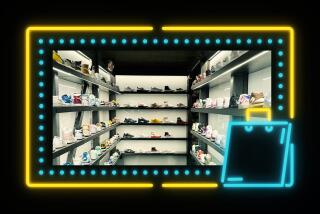Covering All the Retail Bases
- Share via
Where is the online world headed? Offline, in a big way--even as bricks-and-mortar competitors and catalog companies continue to leap onto the Web.
The movement is evident at Lucy.com, which launched its Web site late in 1999 and immediately began mailing catalogs showcasing its women’s workout gear. In January, the Portland, Ore.-based company will open a boutique in a New York City health club.
“We realized almost from the outset that the Web alone won’t provide the kind of customer experience we want,” said Lucy.com co-founder and Chief Executive Sue Levin. “The simple and smart answer is: Let each channel--Web site, catalog and store--do what it does best.”
Artificial boundaries that have separated bricks-and-mortar operations and pure-play online retailers are being trampled by consumers who demand freedom to shop whenever and however they want. If last holiday season’s buzz words were “Internet pure-play” this year’s mantra is “multichannel marketing.” Some examples:
* Despite its Internet heritage, nearly 40% of BlueNile.com’s jewelry and diamond sales are assisted by 30 telephone service representatives who field an average of 600 phone calls daily.
* Online brokerage E-Trade has opened a branch office in a SuperTarget store in Roswell, Ga., that offers banking and investment services. Additional branches are a possibility.
* Barnes & Noble is installing Internet kiosks so customers can order out-of-stock titles from its Barnes&Noble.com; arm. And, when items in Gap Inc. stores are out of stock, salesclerks will use Internet kiosks to order the goods and ship them for free.
* Apparel company Estyle Inc.’s business plan calls for the Los Angeles-based company to move beyond its Babystyle.com and Kidstyle.com Web sites in 2001 and begin selling its private-label apparel in stores.
“Whether you call it seamless shopping or convenience shopping, it’s what people want,” said Alan Johnson, senior vice president of e-commerce for the Internet group at Walt Disney Co., which is installing interactive kiosks in stores and encouraging catalog shoppers to return goods at Disney Stores. “Now, it’s 24/7, 365 days a year, and that’s just to be in the game. Consumers are demanding uninterrupted access.”
Multichannel marketing is, at heart, a new twist on an old theme for Sears, Roebuck & Co. and other retailers that have operated stores and catalog operations for more than a century.
“You go through a wave of people thinking they can reinvent the business and then realize that customers think and shop in multiple ways,” said David Cooperstein, an online analyst with Forrester Research.
“If you have the physical infrastructure in place for distribution, it’s not a big step to add another channel,” said Ira Kalish, Los Angeles-based director of global retail intelligence for PricewaterhouseCoopers. “A good example of that is Victoria’s Secret, which has stores, a catalog and a Web site. They’re all integrated and they each serve to reinforce the other.”
Real-world players are also flexing their online muscles. Nielsen/NetRatings reports that traffic on Web sites operated by bricks-and-mortar companies rose by 103% during the first five weeks of the holiday season, compared with a 77% increase generated by pure-play e-tailers.
Some e-tailers will survive the consolidation, but, “what’s likely to happen here and around the world is that the principal success stories are going to involve multichannel retailers,” Kalish said. “Even Amazon.com, a pure-play, has talked about the possibility of opening stores.”
Some “dot-coms” are hoping catalogs and stores will speed revenue growth and profitability. But adding multiple distribution channels can be risky.
Gazoontite.com opened a Web site and a retail store in San Francisco in May 1999 and envisioned a nationwide chain of stores that would complement its online presence. Instead, the San Francisco-based company recently filed for Chapter 11 bankruptcy protection and closed two of its five stores.
Dot-coms that step into the real world aren’t abandoning their online roots.
“The guts of our business is going to be on the Internet,” said Laurie McCartney, founder of Estyle. “For certain clothing lines, though, consumers will want to see them in catalogs. Or they might want to see the apparel in stores where they can actually feel the fabric.”
Estyle launched its flagship Babystyle.com Web site in 1999 and quickly began mailing catalogs to develop brand awareness. The company’s marketing also has relied on traditional media, including the sponsorship of a 130-page magazine published by Martha Stewart Living that targets new parents.
BlueNile’s founders are using the power of the Internet to showcase thousands of diamonds. But it is relying on the telephone to “provide a human element,” marketing director Kevin Keith said. BlueNile.com visitors typically spend at least two hours browsing the company’s Web pages and many are men who have never bought a diamond.
“Some of them are very comfortable buying on the Internet, but when you’re buying a diamond it’s not like getting a CD or a sweatshirt,” said Stephanie Kellis, a former Disney Store sales manager who now counsels potential BlueNile.com shoppers by telephone. “Most men I talk to are buying something they know very little about.”
Jason Smith, business development manager for EToys.com in Santa Monica, knew what he wanted when he went online to buy a diamond engagement ring and a wedding band. Like most of BlueNile’s customers, he researched his purchase online and visited several stores to compare prices.
The customer service agents came into play when Smith couldn’t find the exact rings he wanted. After a few brief conversations, he closed the deal online. “The price was $2,000 to $3,000 below what I’d found it for at jewelry stores in L.A. and Santa Monica.”
Telephone service agents and catalogs boost the cost of each sale. Levin expects Lucy.com’s sales to be evenly split between catalogs and its Web site in 2001. Though it’s more costly to service catalog customers, Levin views the expense as prudent. “We want women to be able to shop with us through whatever channel is most convenient for them,” said the former Nike Corp. executive.
Catalogs also are playing an integral role at start-ups that no longer enjoy access to capital that fueled last year’s massive wave of largely ineffective dot-com advertising. “We’re generating $3 in sales for every $1 spent on catalogs,” Keith said.
Carefully designed catalogs can be more effective than Web sites when it comes to shedding light on a new brand--particularly among the vast majority of consumers who rely on slow-speed modems.
“In five seconds, as you flip through the catalog, you get a real sense of who we are, of what we believe in,” Levin said. “Web sites can’t do everything they’re being asked to do. This small space has to tell you all about the brand, give your personality, your point of view, as well as tell consumers what we’ve got to sell.”
That’s not news to Sharper Image, Lands’ End and Chef’s Catalog, all of which moved online in the mid-1990s. At the time, many companies feared that online sales would cannibalize other venues. But savvy catalog operators realized that online sales generally reduced printing, postage and telecommunications costs.
Similarly, dot-com operators are confident that e-mail will evolve into a powerful direct-marketing tool. But rather than waiting for e-mail to mature, many dot-coms are harnessing the proven power of direct mail. “When it comes to discovering prospective customers, it’s harder to get highly qualified [candidates] from e-mail,” McCartney said. “There are legal issues as well for e-mail, but with direct mail, people have been managing lists for years.”
San Diego-based Gateway Inc., which took its first phone order in 1985 and moved onto the Internet in 1996, raised eyebrows a year later when it began opening bricks-and-mortar stores. The chain now has 349 stores, each staffed with 15 employees, and plans to open 100 more stores in 2001. Gateway also has announced plans to put employees in 1,000 OfficeMax retail stores to promote its products.
“The beauty of the Internet is that it cuts down on transaction costs,” said John Spelich, Gateway’s director of corporate communications. “But we know that there’s still a significant portion of our clientele that would never buy a PC sight unseen.”
Gateway’s multichannel system “encourages cross-shopping,” Spelich said. “Our statistics show that people who buy at Gateway look at two or more channels. They may come into the store, do research online and call on the telephone. That’s the way it’s supposed to work. We aren’t trying to force people to go one way or the other.”
Bricks-and-mortar chains also are warming to the idea of online sales. “The idea is that we make it as difficult as possible for our customers to take their business to someone else,” said Gap spokesman Jack Dougherty. “If we can take care of them in their living room, ordering online, terrific. If they come in, hopefully their item is in stock. If they get there and it’s not, we want to order it and make sure it gets to them. If they’re not pleased with it, they can return it to the store.”
The allure of a store is real. “Bricks-and-mortar stores bring the visual presence,” said analyst Cooperstein. “You don’t spend money every time someone sees your store’s sign, but you do spend money online every time you put a banner ad in front of someone.”
More to Read
Inside the business of entertainment
The Wide Shot brings you news, analysis and insights on everything from streaming wars to production — and what it all means for the future.
You may occasionally receive promotional content from the Los Angeles Times.










